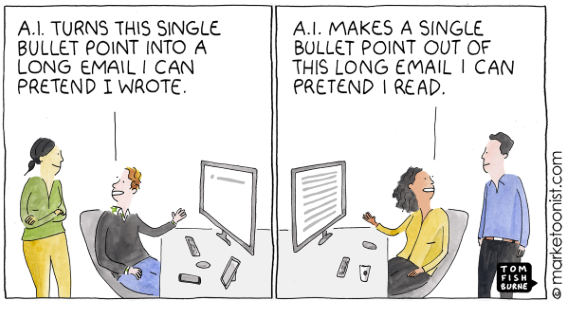Generative Artificial Intelligence (AI) has garnered significant attention and excitement in recent years. It has the remarkable ability to create new content, imitate human creativity, and produce unique outputs. However, while generative AI holds immense promise, it is important for leaders to recognize that it currently serves primarily as an optimization tool rather than a comprehensive solution to all customer issues. In this blog post, we will explore why leaders should prioritize solving customer problems over relying solely on generative AI, and why it should be viewed as a critical part of growth rather than the ultimate answer today.
The Power of Generative AI
Generative AI technology has revolutionized various industries by enabling machines to generate content such as text, images, and even music. These models are trained on vast amounts of data and can create highly realistic and novel outputs. For instance, generative AI can assist in content creation, product design, and even simulate realistic scenarios for training purposes. It has the potential to streamline workflows, enhance creativity, and optimize processes.

The Limitations of Generative AI
- Bias and Ethics: Generative AI models learn from the data they are trained on, which can perpetuate biases present in the training data. This poses ethical challenges, especially when deploying AI systems that generate content or make decisions impacting individuals or communities. Leaders must exercise caution to ensure fairness, transparency, and accountability.
- Lack of Contextual Understanding: While generative AI can generate impressive outputs, it often lacks a deep understanding of the underlying concepts. It may produce plausible but incorrect or nonsensical content. This deficiency can hinder its ability to truly solve complex customer issues that require nuanced comprehension.
- Unpredictability and Overfitting: Generative AI models have a tendency to overfit the training data, meaning they become too specialized in generating outputs that resemble the training data but may lack diversity or adaptability. This can limit their ability to address unique customer requirements and respond effectively to dynamic market conditions.

Solving Customer Issues: The Primary Focus
Despite its remarkable capabilities, generative AI has inherent limitations that make it crucial for leaders to approach it as an optimization tool rather than a panacea. Here are a few key considerations:
To drive meaningful growth and establish long-term success, leaders need to prioritize addressing customer issues directly. While generative AI can play a crucial role in optimization, it should be seen as a tool to enhance existing solutions rather than a standalone solution in itself. Here’s why:
- Customer-Centric Approach: Solving customer issues requires a deep understanding of their pain points, preferences, and aspirations. By focusing on customer-centric problem-solving, leaders can develop tailored solutions that meet specific needs, leading to improved customer satisfaction and loyalty.
- Holistic Problem Solving: Many customer issues involve a multitude of factors that go beyond content generation. Leaders must take a comprehensive approach, considering user experience, functionality, accessibility, and social impact. Generative AI, while valuable, cannot address all these dimensions on its own.
- Human Creativity and Expertise: Generative AI can augment human creativity and expertise, but it cannot replace them entirely. Human judgment, intuition, and empathy are indispensable when it comes to solving complex customer problems that require a deep understanding of context and emotional intelligence.
- Ethical and Responsible Innovation: Leaders have a responsibility to ensure that AI technologies are deployed ethically and responsibly. Over-reliance on generative AI without addressing customer issues directly can lead to unintended consequences, reinforcing biases or neglecting critical aspects of user needs.
Let’s explore examples of how solving customer issues directly can be more effective than relying solely on generative AI in the context of product development and customer service.
Product Development: Imagine a company that specializes in designing ergonomic office chairs. They have a loyal customer base, but some customers have been experiencing discomfort after prolonged use. While generative AI could be used to generate new chair designs, it might not effectively address the underlying issue. Instead, the company decides to focus on solving customer issues by conducting in-depth user research and gathering feedback. They discover that the discomfort is primarily caused by inadequate lumbar support. By redesigning the chair with an adjustable and supportive lumbar system based on customer feedback, the company effectively solves the customer issue and improves overall customer satisfaction.
Customer Service: Consider an e-commerce platform that uses generative AI to automatically generate responses to customer inquiries. While this can streamline the customer service process, it might not always provide the most effective solution. For example, a customer might have a complex issue related to a faulty product they received. Instead of relying solely on generative AI-generated responses, the customer service team engages in active listening and empathetic communication to understand the customer’s concerns. They then provide personalized assistance, including troubleshooting steps, replacement options, or refunds. By addressing the customer issue directly, the company not only resolves the problem effectively but also builds trust and loyalty with the customer.
In both examples, while generative AI could play a supportive role in optimizing processes, it is the direct focus on customer issues that leads to more effective solutions. By prioritizing customer-centric approaches and leveraging human expertise, companies can achieve better outcomes, enhance customer satisfaction, and foster long-term growth.
Generative AI is undoubtedly a powerful tool with tremendous potential for optimization and enhancement. However, it is essential for leaders to recognize its limitations and prioritize solving customer issues directly.





